AMD FX-8320E CPU Review: The Other 95W Vishera
by Ian Cutress on January 13, 2015 10:00 AM ESTProfessional Performance: Windows
Agisoft Photoscan – 2D to 3D Image Manipulation: link
Agisoft Photoscan creates 3D models from 2D images, a process which is very computationally expensive. The algorithm is split into four distinct phases, and different phases of the model reconstruction require either fast memory, fast IPC, more cores, or even OpenCL compute devices to hand. Agisoft supplied us with a special version of the software to script the process, where we take 50 images of a stately home and convert it into a medium quality model. This benchmark typically takes around 15-20 minutes on a high end PC on the CPU alone, with GPUs reducing the time.
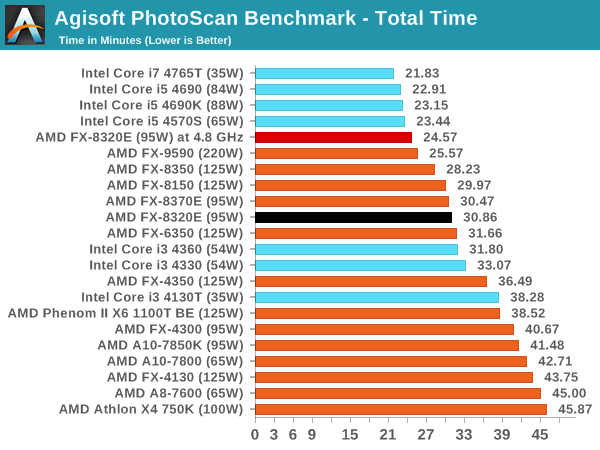
A highly parallel benchmark like Photoscan puts the FX CPUs ahead of our i3 results. When overclocked, it plays just behind the i5 results.
Cinebench R15
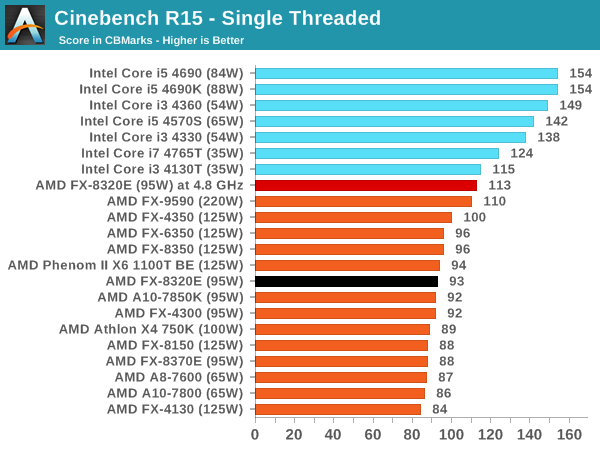
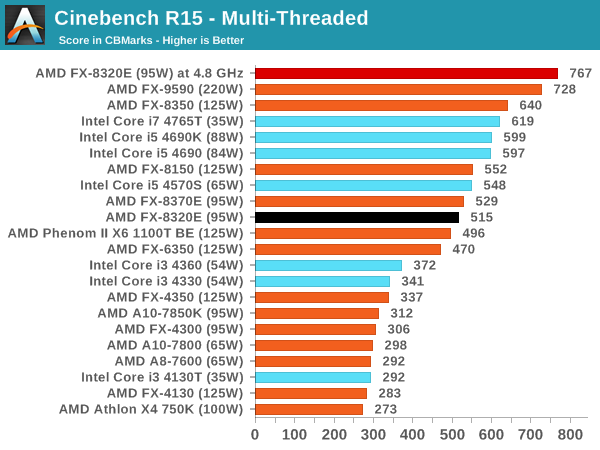
Professional Performance: Linux
Built around several freely available benchmarks for Linux, Linux-Bench is a project spearheaded by Patrick at ServeTheHome to streamline about a dozen of these tests in a single neat package run via a set of three commands using an Ubuntu 14.04 LiveCD. These tests include fluid dynamics used by NASA, ray-tracing, molecular modeling, and a scalable data structure server for web deployments. We run Linux-Bench and have chosen to report a select few of the tests that rely on CPU and DRAM speed.
C-Ray: link
C-Ray is a simple ray-tracing program that focuses almost exclusively on processor performance rather than DRAM access. The test in Linux-Bench renders a heavy complex scene offering a large scalable scenario.
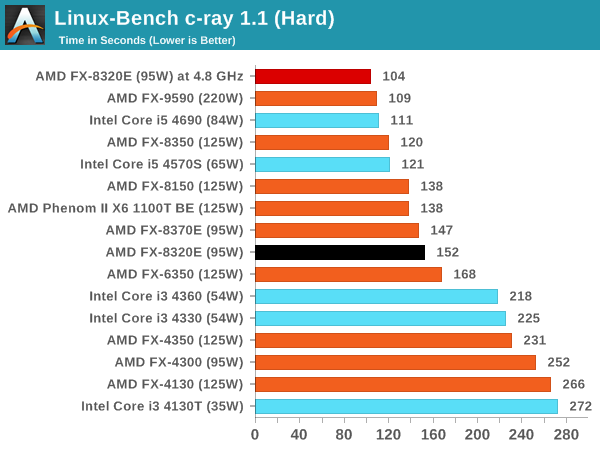
Ahead of the i3, behind the i5 until overclocked seems to be a good motto for this CPU.
NAMD, Scalable Molecular Dynamics: link
Developed by the Theoretical and Computational Biophysics Group at the University of Illinois at Urbana-Champaign, NAMD is a set of parallel molecular dynamics codes for extreme parallelization up to and beyond 200,000 cores. The reference paper detailing NAMD has over 4000 citations, and our testing runs a small simulation where the calculation steps per unit time is the output vector.
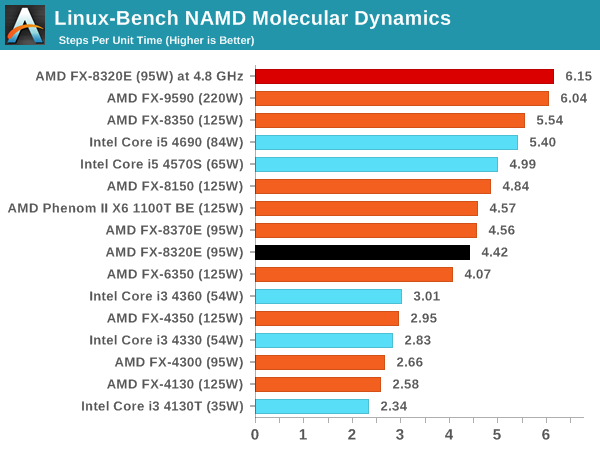
NPB, Fluid Dynamics: link
Aside from LINPACK, there are many other ways to benchmark supercomputers in terms of how effective they are for various types of mathematical processes. The NAS Parallel Benchmarks (NPB) are a set of small programs originally designed for NASA to test their supercomputers in terms of fluid dynamics simulations, useful for airflow reactions and design.
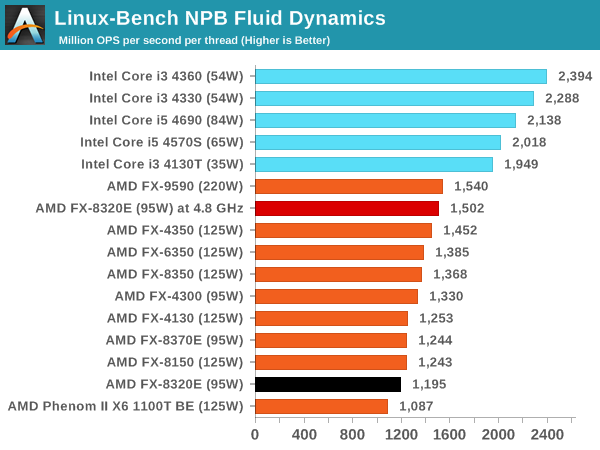
Redis: link
Many of the online applications rely on key-value caches and data structure servers to operate. Redis is an open-source, scalable web technology with a b developer base, but also relies heavily on memory bandwidth as well as CPU performance.
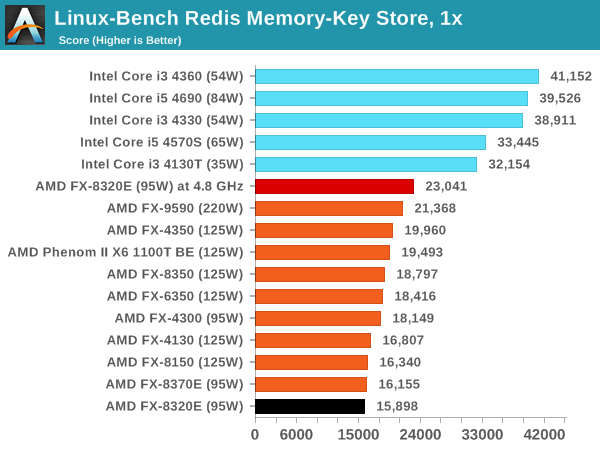
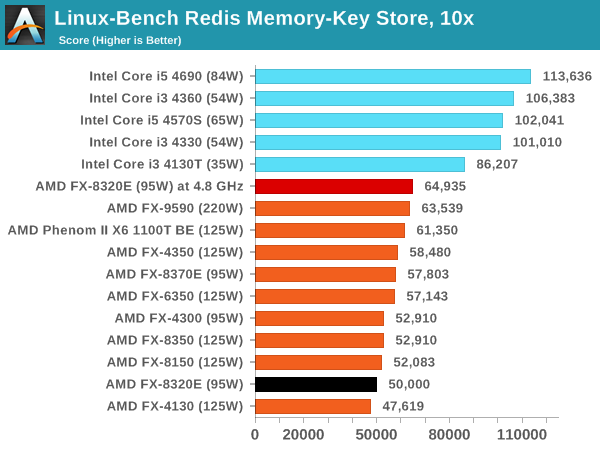
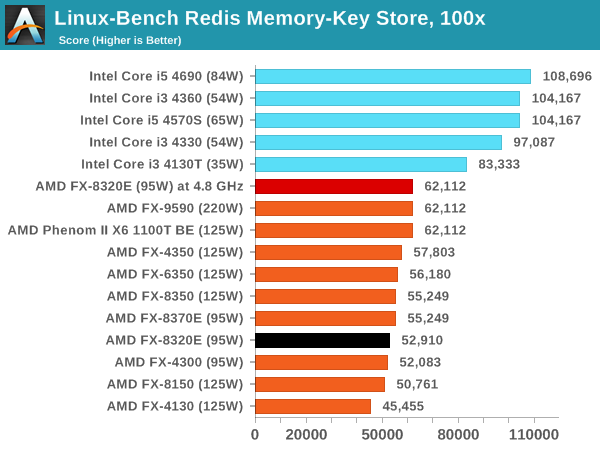
It would seem that one downside to the AMD FX line is the memory access limited scenarios, unless more cores can come into the equation. For redis, that is unfortunately not the case.










92 Comments
View All Comments
xenol - Tuesday, January 13, 2015 - link
Since I can't seem to edit (or it's not made obvious)...I wanted to point out if a program is "single-threaded", it's using a synchronous threading model, where in threads will wait in line to be run. I'm pretty certain a lot of modern programs are asynchronous.
eanazag - Tuesday, January 13, 2015 - link
With an updated chipset and new manufacturing node, this CPU could still play in the market.At release the 900 series chipset was better than Intel's current solution which had no USB 3 and no SATA 3. It took a generation too long for Intel to catch up with SATA 3 (Sandy Bridge). At Ivy Bridge Intel passed AMD in every aspect.
We're talking Broadwell now and it is plain sad at this point. The Core i3's from Haswell beat the processor much of the time when not overclocked. The value proposition is not in AMD's favor unless some just wants to overclock something.
hojnikb - Tuesday, January 13, 2015 - link
>At release the 900 series chipset was better than Intel's current solution which had no USB 3 and no SATA 3Not really. 900 didnt have native usb3 (so pretty much the same deal as intel -- they had to use 3rd party solution). And in 2009, sata6g wasn't really a thing yet (no fast ssds back then).
hojnikb - Tuesday, January 13, 2015 - link
correction; 900 series was released in 2011, where sata6g ssds started to pop up...Laststop311 - Tuesday, January 13, 2015 - link
You just can't defend these FX line cpu's. You are a just a million times better off coughing up an extra 200 dollars and getting a nice z97 board + devils canyon i5 and overclocking it to an easy 4.4ghz. Even in software that can make use of all 8 cores for BD a 4.4ghz i5 devils canyon has a good chance of out muscling it or coming very close and for anything else the i5 just blows BD away.If you are going to buy an AMD FX based system just stop yourself and put 50 dollars away on your next 4 paychecks and get an i5-4690k + Z97 system instead and u will be much happier. Even if for some reason i had to have 8 cores in my next system i'd spend an extra 1400 or whatever and get an i7-5960x + x99 system. It's disgusting that an 4.0+ghz overclocked phenom II x6 1100t can outperform the new FX chips at MANY tasks and I would actually recommend an AMD buyer to just get an 1100t with quality water cooling over a current FX chip can find super cheap 1100t's which makes the 1100t + good water cooling the same price as a new FX + decent air cooler and u can just get better performance with the massively OC'd 1100t.
III-V - Tuesday, January 13, 2015 - link
>You just can't defend these FX line cpu's.Oh yes you can. There are thousands of people in the AMD Defense Force that do just this every day.
silverblue - Wednesday, January 14, 2015 - link
Haha I like this one. :)jabber - Thursday, January 15, 2015 - link
To me the difference is like going into a restaurant and ordering the AMD pizza which comes in at 15" for $20 or ordering the Intel pizza which is 18" and costs $5 more. Most people probably can't manage to eat the AMD let alone the Intel.It's not like we are back in the days with AMD stuck at 20 FPS average and Intel at 30FPS average.
Oxford Guy - Thursday, January 15, 2015 - link
That's a really awful analogy. If your primary taxing use for your computer is gaming then AMD processors are a poor option.jabber - Friday, January 16, 2015 - link
Not really."Oh noooo my $100 AMD chip is only giving me 86FPS!" How terrible!
How did we manage back in the 1990's.